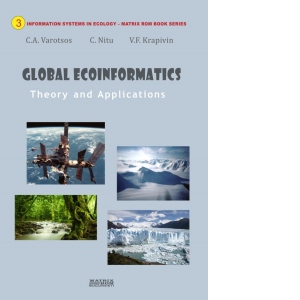Global Ecoinformatics. Theory and Applications
de: Costica Nitu, Vladimir F. Krapivin, Costas A. Varotsos
Publicat de: Editura Matrixrom
Anunta-ma cand revine pe stoc!List of abbreviations and acronyms
Chapter 1. Globalization and problems of sustainable development
1.1. Introduction
1.2. Trends in civilization development
1.3. Sustainable development problems
1.4. Global ecodynamics priorities
1.5. Global dynamics of ecosystems: Natural and anthropogenic impacts
1.6. Present global ecodynamics
1.7. Global energetics development in the context of global ecodynamics
1.8. Conclusion. Unsolved problems
Chapter 2. New information technology for environmental monitoring
2.1. New concept of geoinformation monitoring technology
2.2. Principal aspects of the GIMS technology
2.3. The GIMS structure
2.4. The GIMS-based research remote sensing platforms
2.5. Spectroellipsometric tools for the water quality diagnostics in the Sea of Okhotsk
2.6. A modeling system for monitoring water quality in lagoons
2.7. Remote-sensing tools and ecoinformatics
2.8. Microwave radiometry in remote monitoring of the ocean
2.9. Typical inverse task of microwave radiometry
2.10. Conclusions
Chapter 3. The NSS model as the GIMS component
3.1. The problem of global modelling
3.2. Global model and GIMS
3.3. The NSS global modelling
3.4. Climate unit of the global model
Chapter 4. Natural disasters as components of global ecodynamics
4.1. Evolution of the biosphere and natural disasters
4.2. Wildfires as a component of global ecodynamics
4.3. Thunderstorms as a component of global ecodynamics
Chapter 5. The role of biogeochemical cycles in global ecodynamics
5.1. Biogeochemical cycles and quality of life
5.2. Biological, chemical, and physical indicators for the quality of biogeochemical cycles
5.3. The role of living processes in the biogeochemical cycles
5.4. Simulation results from a coupled model of carbon dioxide and methane global cycles
Chapter 6. Ecoinformatics and soil-plant formations
6.1. Methodology, theory and problems
6.2. Global dynamics of the land ecosystems
6.3. Modeling the vegetation dynamics
6.4. The role of forests in CO2 cycle
6.5. Vegetation media as a tool in the study of attenuation of electromagnetic Waves
6.6. Microwave model of vegetation cover
6.7. Land cover classifications
Chapter 7. Ocean environment and global ecodynamics
7.1. Arctic Basin pollution problems
7.2. High-latitude environment science
7.3. Simulation model of the Arctic Basin ecosystem
7.4. An expert system for the Okhotsk Sea investigation
7.5. Arctic biocomplexity
7.6. Ecoinformatics problems of the ocean
7.7. Estimation of oil hydrocarbon pollution parameters in sea water
7.8. Monitoring of the oil and gas extraction zone in south-China sea
7.9 Adaptive technologies and sea navigation
Chapter 8. Decision making risks in global ecodynamics
8.1. Risk control and sustainable development
8.2. Indicators of the efficiency of risk control in cases of natural disasters
8.3. Social and human dimensions of risk
8.4. Estimation of risk in the monitoring regime
8.5. Decision making scenario for the Aral-Caspian hydrological system renewal
8.6. Decision making risks in tropical cyclogenesis References Index
| General | |
| Anul | 2018 |
| Autor | Costica Nitu, Vladimir F. Krapivin, Costas A. Varotsos |
| Categorii | Invatare Limbi Straine, Limba Engleza, Ecologie, Stiintele Naturii, Carti |
| Editura | Editura Matrixrom |
| Limba | Engleza |






